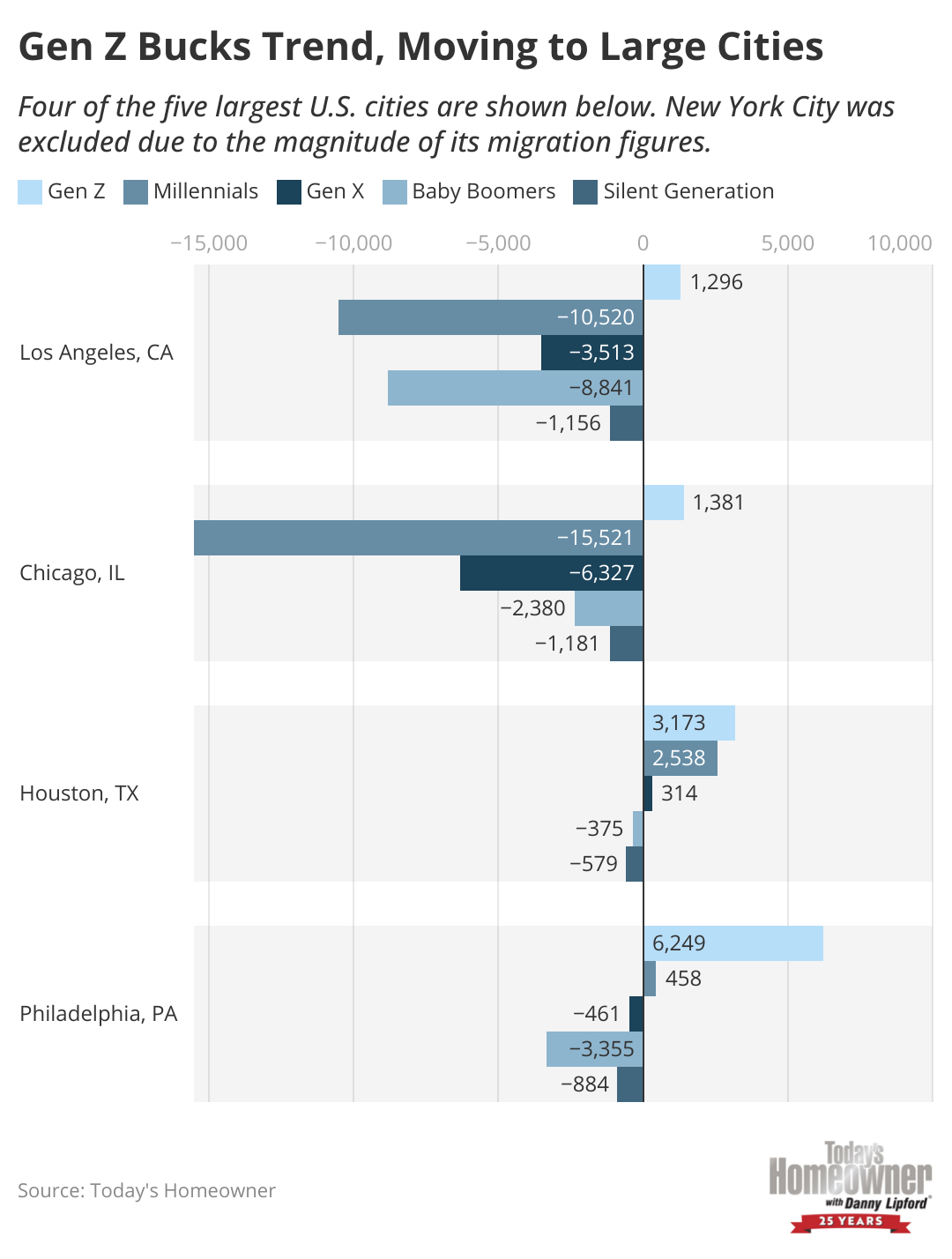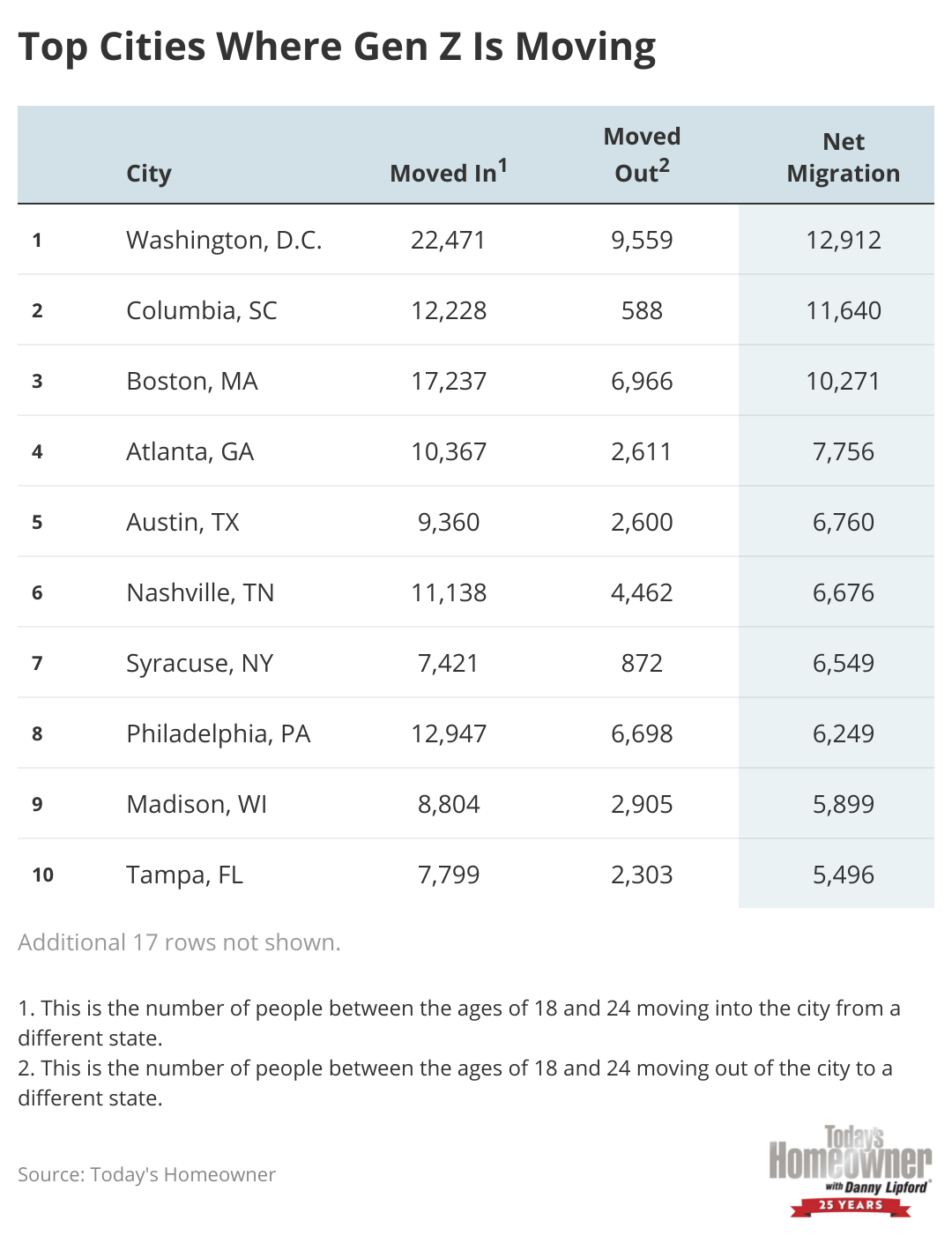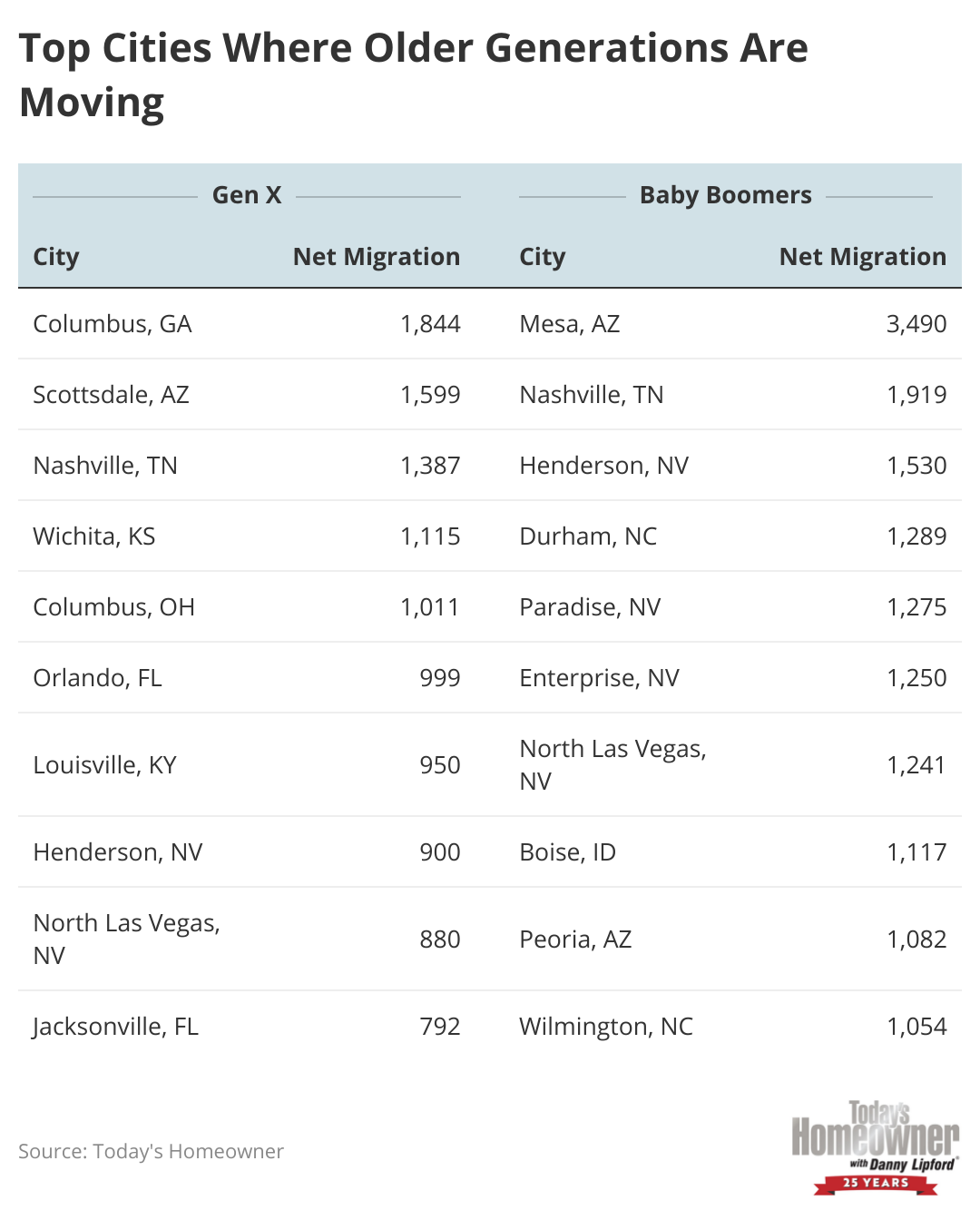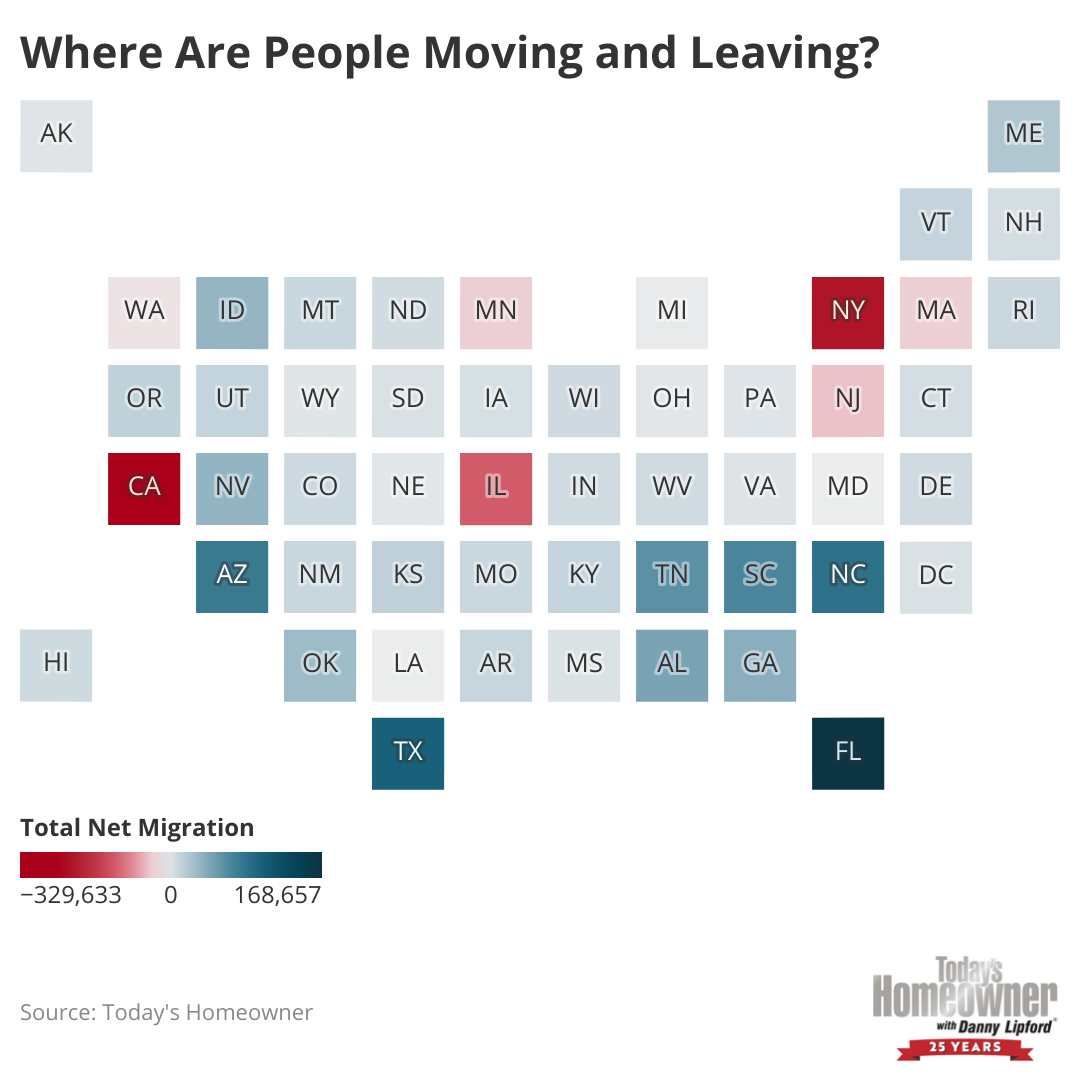Gen Z heads to major cities as other generations leave

Canva
Gen Z heads to major cities as other generations leave
A crowd of young people walking away on a busy city street.
According to Census data and private surveys, the average U.S. resident moves more than 11 times in their lifetime. In contrast, the average number of moves for European citizens is only four.
Depending on which stage of life you’re at, different push and pull factors are in play when you decide whether to move or stay put. With that in mind, the research team at Today’s Homeowner analyzed Census Bureau data to better understand where people are moving to, where they’re moving from, and how each generation’s moving patterns differ. We examined trends for five generations, including Gen Z, millennials, Gen X, baby boomers, and the Silent Generation. Check out the Methodology section below for more information on our data and sources.
![]()

Today’s Homeowner
Main Findings
Bar chart showing Gen Z moving to larger cities as other generations leave.
- Southeastern states and cities had some of the largest migration gains, suggesting warm weather and lower costs of living are significant factors in determining where to move.
- Major metropolitan areas are seeing population losses for each generation except Gen Z. The five largest U.S. cities – New York City, Los Angeles, Chicago, Houston, and Philadelphia – all had net migration increases for Gen Z while showing major net decreases for all other generations.
- Millennials have undertaken a mass exodus from large cities, leaving New York City (-96,631), Chicago (-15,521), and Washington, D.C. (-11,559) at the highest rates.
- None of the top cities Gen Zers are moving to are in the West. The top three cities are Washington, D.C.; Columbia, SC; and Boston, MA.
- The five most popular states people are moving to are: Florida (+168,657), Texas (100,757), North Carolina (+84,996), Arizona (+76,467), and South Carolina (+66,682).
- People are moving away from Northeastern states and cities, with those places registering the largest outflows in population.

Today’s Homeowner
Where Are Younger Generations Moving To and From?
Chart showing the top cities where Gen Z is moving.
Our research found that the two youngest generations, Gen Z and millennials, had some peculiar moving trends. Firstly, the youngest group of adults, Generation Z, consistently showed starkly different moving preferences than other groups. While overall trends show Americans moving out of big cities and expensive states and toward areas with warmer climates and lower costs of living, Gen Z often bucked this trend.
When looking at the cities that Gen Z was moving away from, we see Orlando, Denver, San Jose, and Newark topping the list. What is most surprising about this list is that it doesn’t include the megacities of New York, Los Angeles, or Chicago — all cities that the millennial, Gen X, baby boomer, and silent generations are leaving in droves.
In fact, many of those Gen Z residents are heading to the same big cities that older generations have potentially deemed too expensive or crowded. New York City, Los Angeles, Chicago, Houston, and Philadelphia all had net migration increases for Gen Z despite showing net decreases for all other generations.
One of the largest divisions regarding moving in the younger generations can be seen in the trends surrounding New York City. The Empire State was the top loser of residents across all age groups but lost the most specifically to millennials, as more than 96,600 members of this generation fled NYC.
However, Gen Z did not seem to mind the Big Apple, as this city had a net gain of over 3,043 members of this generation — this was the largest net gain for NYC across all age groups. Other large cities which saw similar gains include D.C., Columbia, and Boston, each with a net migration of over 10,000 Gen Z per city.
Despite Columbia’s strong showing among the young movers, broadly speaking, both of the younger generations appear to be more interested in an area’s opportunities and dynamism rather than its value. However, millennials also appear to value lower home costs more than their younger sibling generation. These trends among younger Americans make sense when considering where they are in life, likely looking to build career momentum or settle down into a family home.

Today’s Homeowner
Where Are Older Generations Moving To and From?
Chart showing the top cities where older generations are moving.
Members of Gen X, baby boomers, and the silent generation all tend to prefer warmer, Southern cities, according to the data. All three of the oldest generations showed significant movement to cities like Mesa, or Nashville. The top city for both baby boomers and the silent generation was Mesa. Gen X’s top city to move to was Columbus, Georgia, but Scottsdale, Arizona, saw the second-highest net migration from Gen X.
In addition to the warmer climates and lower state income taxes in those states, there was a tendency for older generations to move out of larger cities as they retired. The cities that saw the most departures of these three oldest generations are all major metropolises. These cities include New York, Los Angeles, Chicago, San Diego, Philadelphia, San Francisco, San Jose, and Seattle.
At the state level, the Southeast and other areas with low-income taxes and warm weather dominate the rankings among older generations. For Gen X, baby boomers, and the silent generation, the state that showed the highest net migration was Florida. Beyond that, results differed somewhat between generations, but states like Texas, North and South Carolina, Tennessee, and Arizona figured prominently in each generation’s top ten lists.
In short, while younger Americans appeared to be moving toward large cities or states with many education or career opportunities, older Americans were likelier to choose areas with lower income taxes and warmer climates. As we can see from the data, where you are in life can determine where you want to live (or don’t want to live).

Today’s Homeowner
Overall State Migration Trends
Chart showing which states people are moving to and leaving across the U.S.
According to our research, the states with the highest gains in overall population are Florida, Texas, North Carolina, Arizona, and South Carolina. These states are the most popular picks for each generation – save for Gen Z – who still choose Northern places like Massachusetts and the District of Columbia as their preferred destinations.
Southern states dominate in migration gains, especially those on the Southeastern coastline. This trend is a stark shift from historical precedent, as Northeastern and Western states once held these top spots.
The states suffering the highest losses include California, New York, Illinois, New Jersey, and Minnesota. From this, it’s clear that states which saw population growth in the past, especially those on the Northern coast with large megacities, are now experiencing record-breaking exoduses.
This big-city flight is especially prevalent in New York. The Empire State has earned a spot on all but one generation’s most-moved-out-of-state list. The one generation that went against the grain was Gen Z, who was the only group with a migratory preference for New York, with over 8,000 moving there.
Looking deeper into the details of Gen Z’s moving trends, we see that they are the only generation that chose to exit Florida, with an outflux of 8,000 young adults, while every other generation moved in. Similarly, Connecticut had net gains from every generation save Gen Z (5,000 of which chose to leave.) In the inverse of this situation, Colorado experienced a large influx of both Gen Z and millennials but losses for every other generation.
Conclusion
Our research reveals several interesting facts about the modern moving trends across different generations. Regardless of age, most Americans want to move into Southern states, specifically those along the East Coast and away from major metropolitan areas.
We see that, of all the generations, Gen Z has some unique preferences regarding the cities and states they want to move to. Unlike all other generations, they prefer large cities and are more likely to move to Northern states.

Canva
Methodology
Legs of people walking away from the camera on a city street.
To find out where people are moving and leaving, Today’s Homeowner analyzed data from the U.S. Census Bureau’s 2021 1-year American Community Survey. We considered the following age ranges for each generation:
- Generation Z: Ages 18 to 24
- Millennials: Ages 25 to 44
- Generation X: Ages 45 to 54
- Baby Boomers: Ages 55 to 74
- Silent Generation: Ages 75+
Then for each generation, we looked at two metrics:
- Moved in. At the city level, this is the number of people moving into the city from a different state. At the state level, this is the number of people moving to the state.
- Moved out. At the city level, this is the number of people moving out of the city to a different state. At the state level, this is the number of people moving out of the state.
Using those figures, we calculated the net migration for 152 cities along with all 50 states and the District of Columbia. Cities with the highest net migration ranked the highest, and vice versa.
This story originally appeared on Today’s Homeowner and has been independently reviewed to meet journalistic standards.